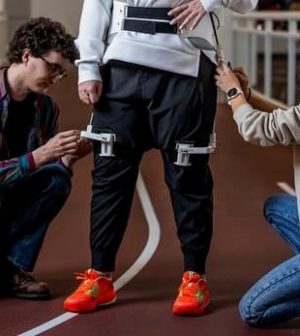- Taking a GLP-1 Medication? Here’s Tips to Holiday Eating
- Bird Flu Virus in Canadian Teen Shows Mutations That Could Help It Spread Among Humans
- Flu, COVID Vaccination Rates Remain Low as Winter Nears
- ’10 Americas:’ Health Disparities Mean Life Expectancy Varies Across U.S.
- Short-Term Hormone Therapy for Menopause Won’t Harm Women’s Brains
- Could a Vitamin Be Effective Treatment for COPD?
- Woman Receives World’s First Robotic Double-Lung Transplant
- Flavored Vapes Behind Big Surge in U.S. E-Cigarette Sales
- Reading Beyond Headline Rare For Most on Social Media, Study Finds
- Meds Like Ozempic Are Causing Folks to Waste More Food
Robotic Hip ‘Exoskeleton’ Helps With Stroke Rehab

A new robotic hip exoskeleton could help stroke patients improve their walking stride, a new study shows.
More than 80% of stroke survivors develop problems walking, often because their step is shorter on one side than the other, researchers explained in background notes.
The hip exoskeleton helps people adapt their stride by forcing both legs to take similar strides, researchers report. It provides powered assistance to the hip with the impaired stride, while also holding back the more capable hip.
“Such a device can be seamlessly integrated into the daily lives of chronic stroke survivors, offering an accessible way to increase training time, which is critical for improving walking,” said lead researcher Banu Abdikadirova, a doctoral candidate in mechanical and industrial engineering with the University of Massachusetts-Amherst.
The new technology is based on a tried-and-true physical therapy for stroke called the split-belt treadmill.
The machine has two side-by-side belts that move at different speeds. Research has shown that repeated training on a split-belt treadmill can improve walking symmetry in stroke patients.
“Split-belt treadmill training is designed to exaggerate a stroke patient’s walking asymmetry by running the belts under each foot at different speeds,” said researcher Woulter Hoogkamer, an assistant professor of kinesiology with the University of Massachusetts-Amherst. “Over time, the nervous system adapts, such that when the belts are set to the same speed, they walk more symmetrically.”
Unfortunately, there are limits to what can be gained from these split-belt machines, researchers said.
“What is learned on a treadmill does not completely transfer to overground contexts,” Abdikadirova said in a university news release. “This is because walking on a treadmill is not exactly the same as walking overground.”
Tests with 13 stroke patients found that the participants adopted a more symmetric gait pattern after using the exoskeleton, in much the same way as with treadmill training, researchers reported recently in the journal IEEE Transactions on Neural Systems and Rehabilitation Engineering.
“We can build upon the successes of split-belt treadmill training with this device to enhance the accessibility of gait training and enhance the transfer of training benefits into everyday walking contexts,” said Mark Price, a postdoctoral researcher in mechanical and industrial engineering and kinesiology with the University of Massachusetts-Amherst.
More information
Mayo Clinic has more about stroke rehabilitation.
SOURCE: University of Massachusetts-Amherst, news release, March 4, 2024
Source: HealthDay
Copyright © 2024 HealthDay. All rights reserved.



-120x134.jpg)




